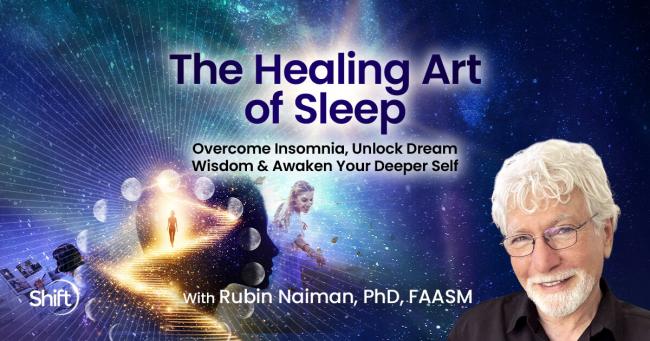Rubin Naiman, PhD, FAASM
Andrew Weil Center for Integrative Medicine
The University of Arizona
I used to wake up at 4 AM and start sneezing, sometimes for five hours.
I finally came to the conclusion that it must be an allergy to consciousness.
— James Thurber
Despite their boasting otherwise, the field of sleep medicine has made painfully little progress around healing insomnia over the past half century. I believe this can be largely attributed to a distorted view of sleep — a view that doesn’t begin to adequately account for the critical importance of dreaming.
Over recent years, mounting evidence has revealed a significant connection between “REM sleep instability” — characterized by brainwave disruptions around dreaming —and chronic insomnia. I believe REM sleep instability is best understood as a psychophysiological “allergic reaction” to shifting from waking into dream consciousness. Odd as it might seem to be “allergic” to a state of consciousness, given science and society’s dismissive posture toward dreams, the link between dreaming and insomnia shouldn’t be surprising.
Certainly there are many among us who respect, value, and proactively engage with dreams. But most of us don’t. Most of us tend to view dreams as meaningless if not outright menacing. Western medicine reinforces this perspective in its dismissal of dreams as an insignificant artifact of sleep. In fact, Western medicine is the only major medical system in the world today that acts as if dreaming is largely irrelevant to health, including mental health. And of course, the most commonly used medications to treat insomnia happen to suppress dreams.
Whether conscious or subconscious, anxious or fearful reactions to dreaming are known as oneirophobia. Google’s AI definition further clarifies that “Oneirophobia is not just a normal apprehension about dreams...” -- implying that it is, in fact, normal to have some apprehension about dreams. Of course, experiencing anxiety about bad dreams and nightmares is understandable. But it’s simply not normal to be apprehensive about dreams on the whole.
Beyond their critical role in supporting mood, memory, creativity, empathy, and even spirituality, dreams are the natural bridge to sleep. Even a cursory glance at sleep architecture reminds us that our nightly slumber normally begins with a rapid hypnagogic or sleep onset dream. For too many of us, however, the process of submitting to sleep through dreaming is fraught with anxiety that underlies insomnia. Archetypal psychologist James Hillman offers us an unflinching analysis of this situation:
“… we need incantations to help us drop off to sleep, a ritual of prayer, tooth brushing and the teddy bear, of … food cramming, and the late show, of night cap and sleeping pill. The basic bedtime story of our culture is that to sleep is to dream and to dream is to enter the House of the Lord of the Dead, where our complexes lie in wait. We do not go gentle into that good night.”
Hillman reminds us that “to sleep is to dream” — that the transition from waking to sleep is mediated by dreaming. He clarifies that it’s “the House of the Lord of the Dead,” the place of challenging dreams, that actually unsettles us. Centuries earlier, Shakespeare’s Hamlet echoed a similar concern in his classic, “To die, to sleep — to sleep, perchance to dream — ay, there's the rub, for in this sleep of death what dreams may come…” Whether at the beginning of the night or intermittently throughout it, insomnia is commonly associated with an allergic-like reactivity or an anxious resistance to dreams.
Oneirophobia is most evident in our waking posture toward dreams. We commonly fail to attend to them or actively dismiss them as in “it’s just a dream…” Even when dreams do get our attention, we typically downsize them by presuming they’re just fun-house mirror reflections of waking life. We also stifle what is deeply personal or potentially transpersonal by relying on pseudoscientific dream dictionaries to guide our interpretation. All of this is further complicated by a sharp reduction of interest in dreams on the part of most American psychotherapists.
Over recent years, I’ve written and spoken extensively about a silent epidemic of REM sleep and dream loss. In fact, much if not most of what we consider sleep loss is actually dream loss. As a result of lifestyles that encourage excessive reliance on medications, alcohol, cannabis, and artificial light at night, we are at least as dream-deprived as we are sleep-deprived. Despite the seriousness of this epidemic, it continues to remain a “silent” one because of our dismissive posture toward dreaming.
The oneirophobia underpinning our dream allergy derives from a long-standing mistrust of the source of our dreams — of the unconscious. From biblical notions about original sin to Freud’s primitive and aggressive id, and neuroscience’s complex but chemically glitchy brain, we have a long history of being suspicious of the unconscious. The Bible, Freud, and neuroscience all share a belief that the unconscious is adaptive, yet ominous.
There certainly are more enlightened perspectives that characterize the unconscious as being trustworthy, wise, and spiritual. Consider notions of Buddhist nobility, the Christ within, or the inner child. Distinguished teachers such as Rumi, Emerson, and Tolle encourage us to approach the unconscious as a great friend, a perspective that invites a more open, positive, and creative view of dreaming.
We should begin with a reconsideration of what dreaming is — and what it’s not. Dreaming, like sleep, is almost exclusively understood in terms of its function in and support of waking life. It maintains and enhances our adaptation to this world. As a result, we see dreaming as a secondary and subservient kind of consciousness — as a subsidiary of waking. But it is not. Dreaming simply can’t be meaningfully understood only from a waking world perspective.
Above and beyond our experience of any particular dream is the larger issue of dreaming as a state of consciousness. Dreaming is, in fact, its own sovereign state of consciousness — a separate reality. It’s a non-linear fluid kind of consciousness that occupies that mysterious region between waking and sleep. In fact, so much of what we call sleepiness is laced with dreaminess, which beckons us to cross the border and leave the waking world.
Our allergic reaction to dreaming is anxiety about that border crossing. Shifting into another state of consciousness is not just about going to another place, it’s also about becoming a different person. Dreaming nudges us nightly toward expanding our sense of self. Willingly crossing the border into dreaming consciousness is an act of faith in another world — in the world behind the waking world.
Healing our dream allergy then is about opening to a rapprochement with dreaming. We can do so by engaging in dreamwork, which refers to a range of practices like dream journaling, dream sharing, dream interpretation, waking dreamwork, and lucid dreaming. Dreamwork is about engaging in an ongoing dialogue with our dreams. Even if some of the conversations don’t always look that way, it presumes that the dreamer inside of us has an otherworldly intelligence and comes in peace.
Join Dr. Naiman in his enriching program to learn more about his compelling system for restoring your relationship with night consciousness so you can reclaim sleep as a portal to your deeper self. Click here or on the image below to learn more!






